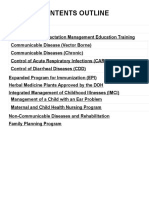1
4th NATIONAL MCQ EXAMINATION NATIONAL BOARD OF EVALUATION, INDONESIAN COLLEGE OF PAEDIATRICS NOVEMBER 19, 2008 SELECT THE ONE BEST ANSWER, put your answers in the answer sheet Time allocation: 100 minutes GROWTH AND DEVELOPMENT
A newborn girl named Sitti presents to the evening nurse in the general care nursery with floppy tone and dysmorphic features. She is born full term to a 28
–
year
–
old G2 P1 whose first pregnancy resulted in a healthy daughter. She has delivered a full
–
term 3
–
kg girl. Pregnancy, labor, and delivery were all uncomplicated. The obstetrician has told the parents that all went well.
A.
What are the medical examination findings that occur in 50% but not in 90% of individuals with Down syndrome ? A.
Mid
–
face hypoplasia B.
Excess nuchal skin C.
Small ears D.
Central hypotonia E.
Wide space between first and second toes
B.
Your examination reveals a clustering of craniofacial dysmorphism, central hypotonia, and a strong Moro. When you come in to discuss your concerns with the family, you should :
A.
Talk to the father alone B.
Tell the nurse what to say to mother C.
Talk to both parents and describe what the process will involve D.
Talk to both parents and say that you do not know what to do for children with Down syndrome E.
Describe in detail all that children with Down syndrome cannot do C.
What medical concern listed below is
not
associated with GI malformations ? A.
Oligohydramnions B.
Vomiting after first feed
C.
Delayed passage of meconium D.
Choking during feedings E.
Double bubble on abdominal radiograph
D.
Which of the following cardiac malformations does
not
commonly occur in infants with Down syndrome ?
A.
Atrioventricular canal B.
Tetralogy of Fallot C.
Hypoplastic left heart syndrome D.
Atrial septal defects E.
Ventricular septal defects
IMMUNIZATION A.
An outbreak of measles is occurring in a large urban city. Measles vaccine can be administered to children as young as : A.
4 weeks B.
4 months C.
6 months D.
9 months E.
12 months
B.
Compared with natural infection with varicella-zoster-virus, varicella vaccine is more likely to result in: A.
Herpes zoster B.
Transmission of virus to contacts C.
Mild varicella disease if breakthrough varicella occurs D.
The serious adverse event of encephalitis E.
Fever

2
ENDOCRINOLOGY
A 10
–
year
–
old boy comes into your office for a routine physical examination. His only complaint is that he
is shorter than all of his friends, and that he can‟t ride the mega roller coaster at the local amusement park
because he is shorter than the requirement. You have followed this child for many years, but most visits have been for illness, and his height has not been measured for the last few years. He is on no medications. He reports occasional fatigue and occasional constipation. On physical examination, his height is less than the 3 rd percentile and he is prepubertal 5. Of the following, which is the
least
likely to help with his diagnosis ? A.
Parental heights B.
Growth velocity C.
Actual height D.
Bone age E.
BMI 6. What is the most likely diagnosis if his growth rate is 5 cm/year, height age is 8 years, and bone age is 10 years ?
A. Constitutional delay of growth and puberty B. Intrinsic short stature C. Hypothyroidism D. Growth hormone deficiency E.
Cushing‟s syndrome
C.
What is the most likely diagnosis if he has abnormal body proportions and a narrow interpedicular distance in the lower lumbosacral area ?
A.
Noonan‟s syndrome
B.
Achondroplasia C.
Hypochondroplasia D.
Klinefelter‟s syndrome
E.
Exogenous obesity
D.
Which of the following is one of the most common causes of short stature in children ?
A.
Familial intrinsic short stature B.
Growth hormone deficiency C.
Poor nutrition D.
Chronic illness E.
Hypothyroidism
INFECTIOUS DISEASE E.
An 18-month-old child presents to the emergency center having had a brief, generalized tonic clonic seizure. He is now postictal and has a temperature of 40
C. During the lumbar puncture (which proves to be normal), he has a large, watery stool, that has both blood and mucus in it. The most likely diagnosis in this patient is: A. Salmonella B. Enterovirus C.
Rotavirus D.
Campylobacter E.
Shigella F.
The 3-year-old sister of a newborn baby develops a cough diagnosed as pertussis by nasopharyngeal culture. The mother gives a history of having been immunized as a child. A correct statement regarding this clinical situation is: A.
The mother has no risk of acquiring the disease because she was immunized B.
Hyperimmune globulin is effective in protecting the infant C.
The risk to the infant depends on the immune status of the mother D.
Erythromycin should be administered to the infant E.
The 3-year-old sister should be immediately immunized with an additional dose of pertussis vaccine
3
G.
A 14-month-old infant suddenly develops a fever of 40.2
C. Physical examination shows an alert, active infant who drinks milk eagerly. No physical abnormalities are noted. The white blood cell count is 22.000/mm3 with 78% polymorphonuclear leucocytes, 18% of which are band forms. The most likely diagnosis is: A.
Pneumococcal bacteremia B.
Roseola C.
Streptococcosis D.
Typhoid fever E.
Diphteria
H.
A 4-year-old child presents in the clinic with mumps. Correct statements about this condition include which of the following? A.
Arthritis is a common presenting complaint in children B.
The disease could have been prevented by prior immunization with killed whole cell vaccine C.
Involvement of the CNS may occur 10 days after the resolution of parotitis D.
Orchitis occur almost exclusively in prepubertal males E.
Subendocardial fibrolastosis is a common complication in this age child
GASTROENTEROLOGY I.
An awake, alert infant with a 2 day-history of diarrhea presents with a depressed fontanel, tachycardia, sunken eyes, and the loss of skin elasticity. The appropriate percent of dehydration is: A.
Less than 1 percent B.
1 percent to 5 percent C.
5 percent to 9 percent D.
10 percent to 15 percent E.
More than 20 percent
J.
An 11-year-old child has been diagnosed with hepatitis C infection. Which of the following may be considered in the treatment of chronic hepatitis C infection? A.
Active vaccination B.
Interferon C.
Gamma globulin D.
Zidovudine E.
Low protein diet
K.
An 8-month-old child regularly regurgitates a large portion of her feeds. In the diagnostic evaluation of gastroeosophageal reflux for this infant, the
least
helpful procedure is A.
Barium swallow and upper GI series B.
Urea breath test C.
Esophageal manometry D.
Esophageal pH probe E.
Technetium 99m scintiscan
L.
A 55-day-old former 27-week premature infant is noted by the neonatal nurse to have a swelling in the left groin extending into the scrotum but not involving the testicle. The swelling is not tender, firm, hot or red, and it does not transilluminate. It seems to resolve with pressure, but returns when the infants begin to perform the Valsalva maneuver. The most appropriate course of action at this point is to: A.
Obtain a surgical consultation B.
Perform a needle aspiration C.
Order a barium enema D.
Order a KUB E.
Do nothing, spontaneous resolution will occur
4
NUTRITION
19. Syndrome of vitamin A deficiency is as follows: xerophthalmia, keratomalacia, hyperkeratosis, growth failure and death. Which of the following option is most likely a part of the syndrome. A.
Conjunctivitis B.
Hordeolum C.
Bitot spots D.
Subconjunctival bleeding E.
Retinal ablation 20. Medium chain triglyceride or MCT is beneficial for certain conditions like cholestasis and premature baby. An explanation for MCT recommendation in those situations is: A.
MCT does not need any lipase for its digestion in guts B.
MCT may directly enter the enterocytes without any support of bile salt C.
MCT has a medium length of carbonic chain, therefore gastric juice easily break down it into small fractions D.
MCT is a polyunsaturated fatty acid which is more accessible in binding bile salt E.
MCT stimulates the production of bile salt that promotes the absorption of dietary fats
NEUROLOGY 21.
A 15 year- old male with a history of complex partial seizures recently moves into your practice area. He comes into your office for a general physical examination. During the visit, he states that he has been seizure
–
free for approximately 2 ½ years. His spells consisted of staring with automatisms, but occasionally they would progress to generalized tonic
–
clonic seizures. As he is concerned about driving next year, he asks you when he can go off his medication. He is currently treated with carbamazepine. The most appropriate response would be which of the following ? A.
“Let‟s obtain an EEG. If that test is normal, there is an approximately 70% chance you will be
seizure
–
free”.
B.
“Never. Epilepsy is a lifelong condition”.
C.
:Children with complex partial seizures need to be seizure
–
free for at least 5 years before a
decision can be made”.
D.
“It all depends on the epilepsy syndrome or type and complex partial seizures seldom go into remission”.
E.
“If a child is seizure
-free for two years it
may be possible to stop their medication straight away”
22. Which of the following antiepileptic drugs are generally considered the first
–
and second
–
line therapies for neonatal seizures ? A.
Diazepam and phenobarbital B.
Phenobarbital and phenytoin C.
Phenytoin and midazolam D.
Phenobarbital and lorazepam E.
Phenobarbital and valproic acid
22.
Which of the following is the most common form of childhood seizures ? A. Complex partial seizures B. Absence seizures C. Infantile spasms D. Benign rolandic epilepsy E. Febrile seizures
23.
Which of the following statements is not true about febrile seizures ?
A. A febrile seizure is considered “complex” if it is prolonged, focal, or occurs multiple times per
febrile illness B. A family history of febrile seizures in a first
–
or second
–
degree relative is a risk factor for the development of febrile seizures C. Developmental delay is a risk factor for the development of a first febrile seizure D. Up to 10 % of patients with febrile seizures develop epilepsy E. Carbamazepine and phenytoin are equally effective in the treatment of febrile seizures should one consider treatment









